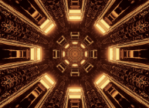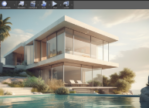Top 10 Benefits of 3D Rendering in Architectural Visualization

Architectural visualization has come a long way from the traditional paper-based models to 3D rendering technology. 3D rendering in architectural visualization is a powerful tool that enables architects, designers, and other stakeholders to visualize their ideas and designs in a more realistic and interactive way. In this blog, we will discuss the top 10 benefits of 3D rendering in architectural visualization.
Better Visualization
One of the most significant benefits of 3D rendering in architectural visualization is that it provides a more realistic and detailed visualization of a design. With 3D rendering, architects and designers can visualize their ideas in a three-dimensional space, which makes it easier to identify potential issues or design flaws. The technology also enables stakeholders to see the design from various angles, helping them to understand it better.
Improved Collaboration
3D rendering in architectural visualization also enhances collaboration among stakeholders. By creating a 3D model, architects, designers, and clients can discuss the design and make changes before construction begins. This saves time and money as it reduces the need for physical prototypes and rework.
Cost-Effective
3D rendering in architectural visualization is cost-effective compared to traditional methods. With 3D rendering, architects can make changes to the design on a computer, which eliminates the need for physical models. Additionally, 3D rendering software is becoming more affordable and accessible, making it a cost-effective solution for architects and designers.
Increased Efficiency
The use of 3D rendering in architectural visualization can significantly increase efficiency in the design process. Since the technology allows architects to visualize their designs in 3D, they can identify and address design issues before construction begins. This reduces the need for rework and saves time and money.
Realistic Lighting and Textures
With 3D rendering technology, architects and designers can simulate realistic lighting and textures in their designs. This creates a more realistic and immersive experience for stakeholders, helping them to better understand the design. Additionally, the technology allows architects to experiment with different lighting and textures, which helps them to make more informed design decisions.
Increased Accuracy
3D rendering in architectural visualization is incredibly accurate. The technology enables architects to create a detailed and accurate model of the design, which reduces the risk of design flaws and errors. This increases the chances of the design being approved by clients and regulatory authorities.
Faster Approval Process
3D rendering in architectural visualization can also speed up the approval process. Since stakeholders can see a realistic and detailed model of the design, they can make more informed decisions about the design. This reduces the need for revisions and approvals, saving time and money.
Improved Marketing
3D rendering in architectural visualization can also help architects and designers to market their designs more effectively. With realistic 3D models, architects can showcase their designs to potential clients and investors, helping them to secure more projects and contracts.
Time-Saving
3D rendering in architectural visualization is a time-saving solution for architects and designers. By creating a 3D model, architects can visualize their designs in real-time, which saves time and reduces the need for physical models. Additionally, the technology enables architects to experiment with different design options, which saves time and speeds up the design process.
Increased Creativity
3D rendering in architectural visualization also encourages increased creativity among architects and designers. The technology allows architects to experiment with different design options and visualize their ideas in a more realistic way. This increases the chances of coming up with innovative and creative designs.
Final Words
In conclusion, 3D rendering in architectural visualization is a powerful tool that provides numerous benefits for architects, designers, and other stakeholders. It enables better visualization, improved collaboration, cost-effectiveness, increased efficiency, realistic lighting and textures, increased accuracy




11111qqqq
123
itstitle
excerptsa